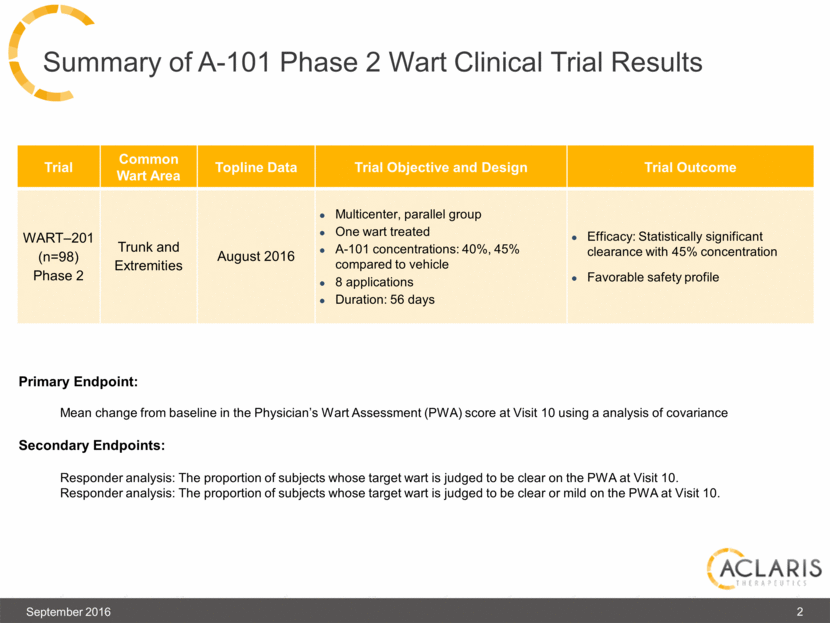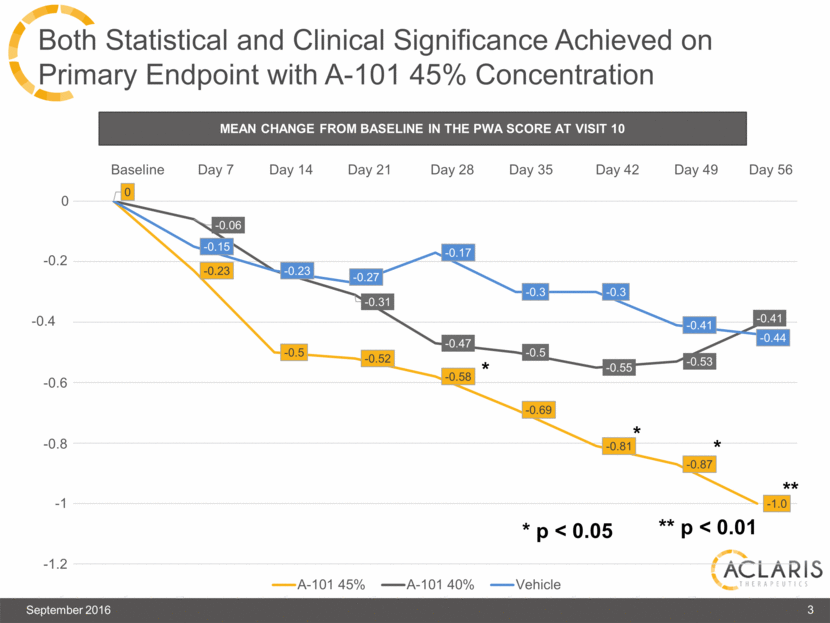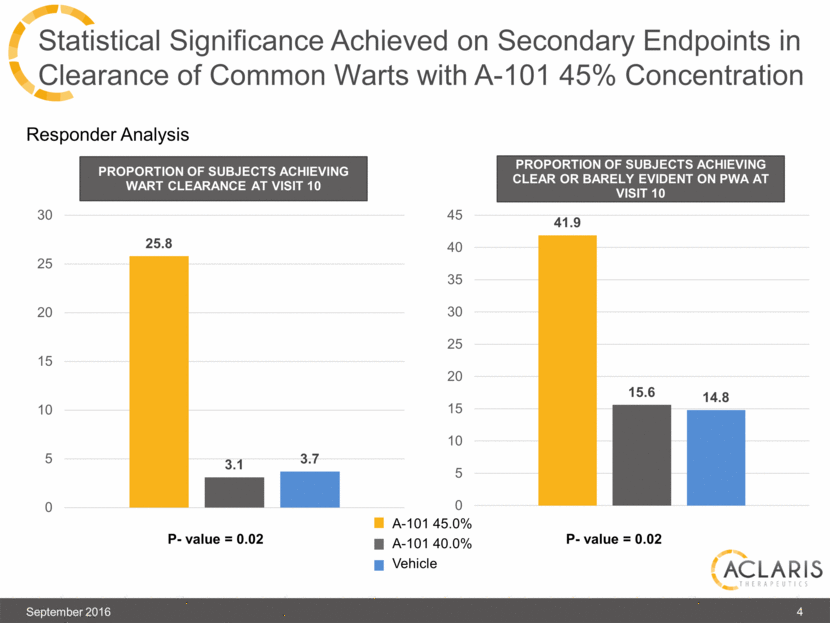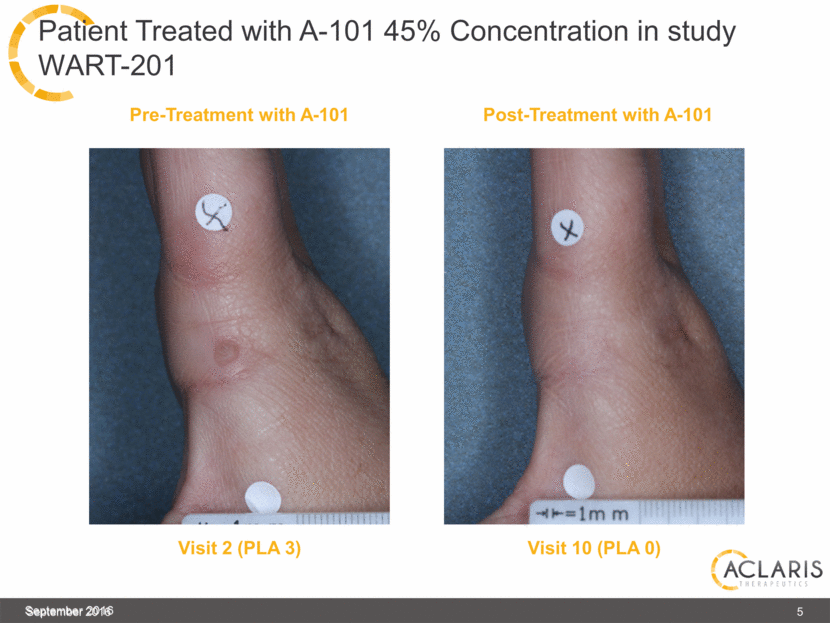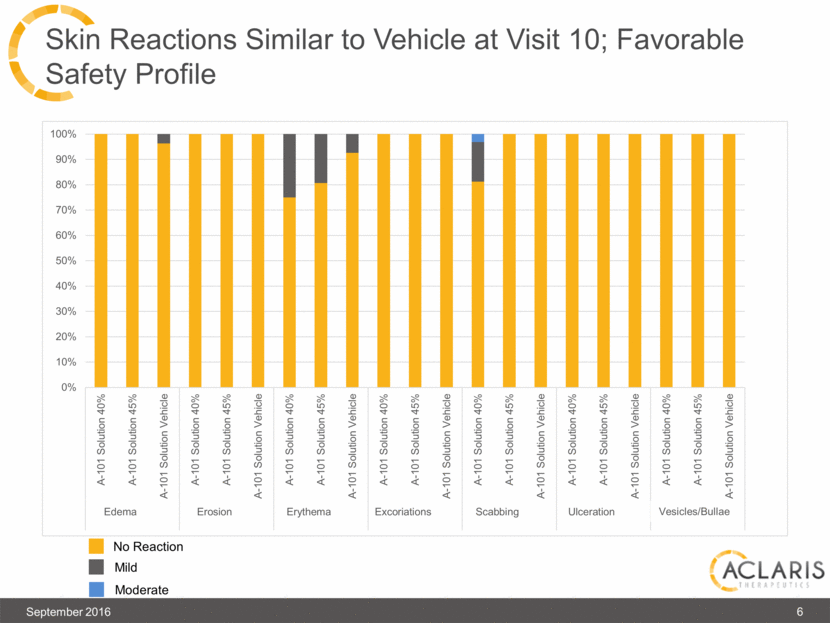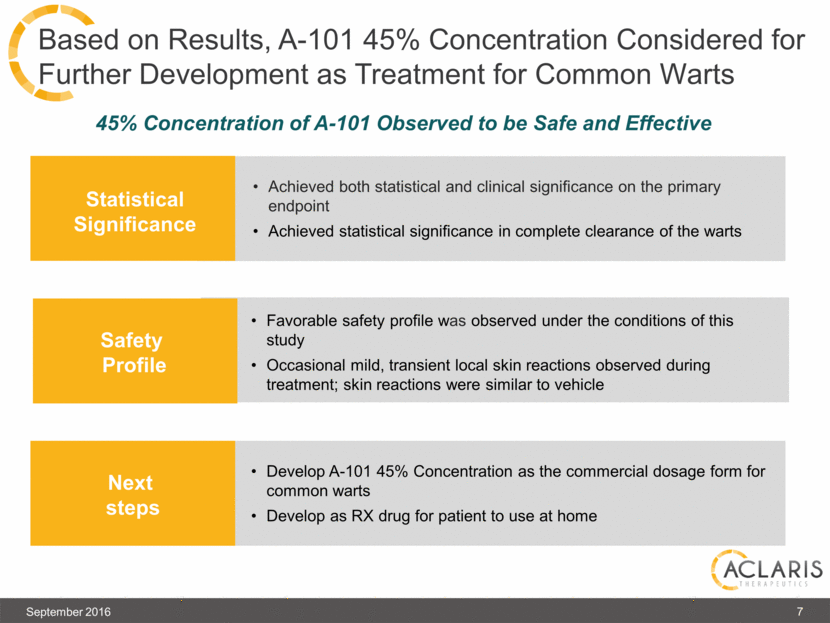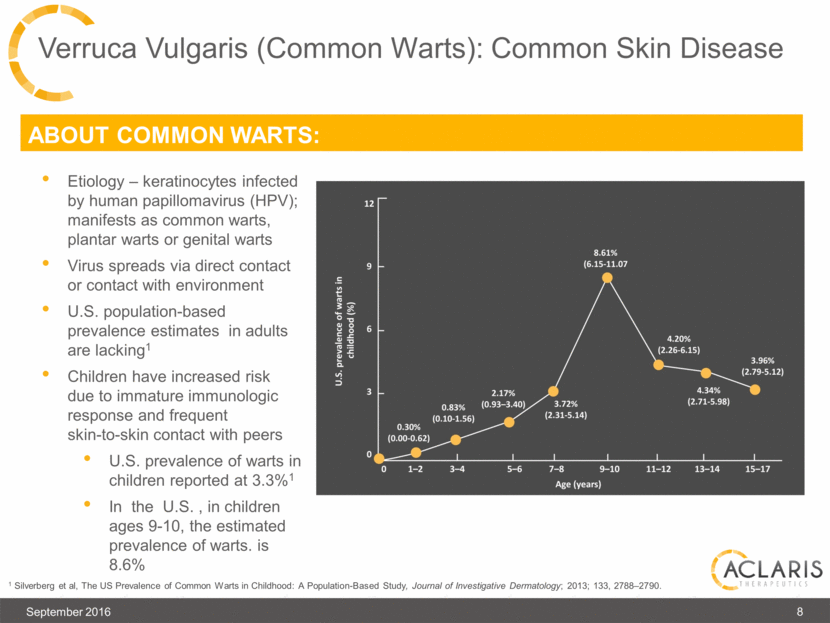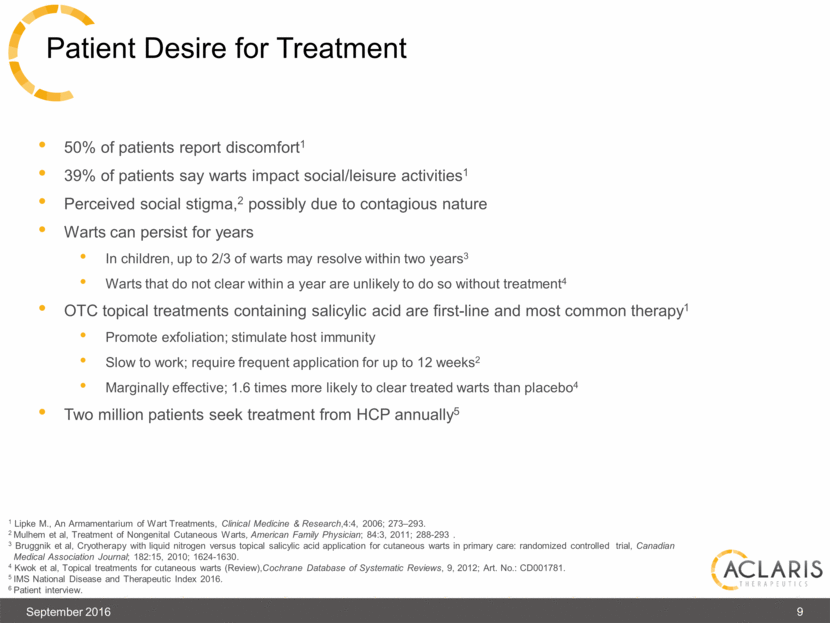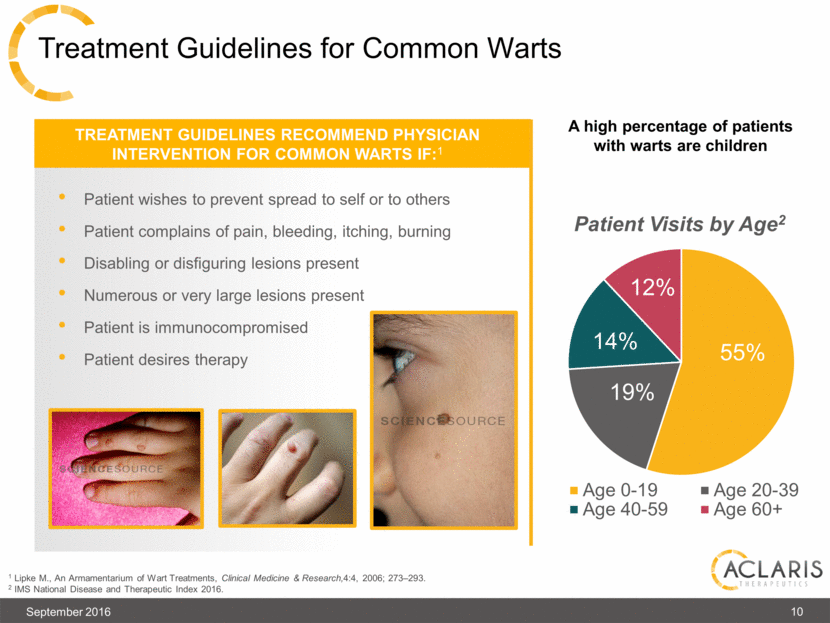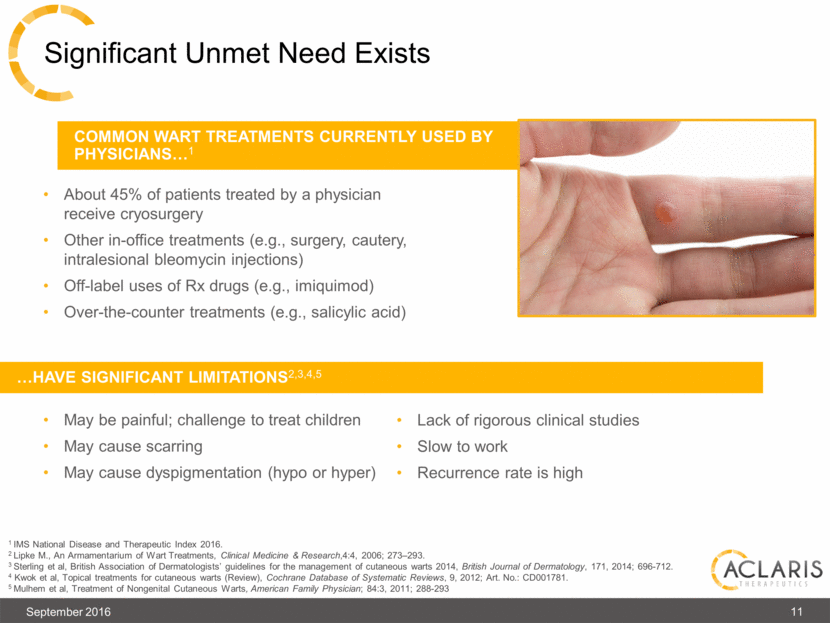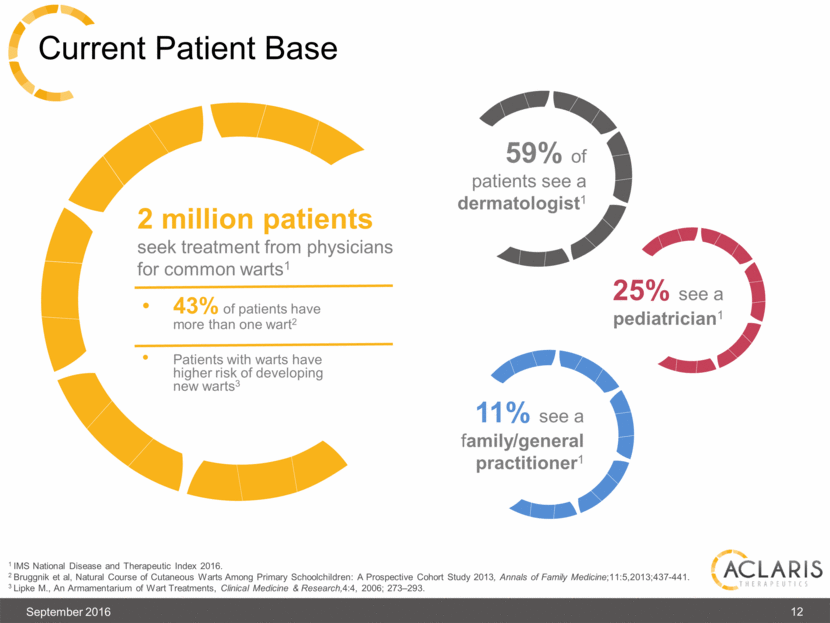Attached files
| file | filename |
|---|---|
| EX-99.1 - EX-99.1 - Aclaris Therapeutics, Inc. | acrs-20160913ex99185d222.htm |
| 8-K - 8-K - Aclaris Therapeutics, Inc. | acrs-20160913x8k.htm |
Exhibit 99.2
|
|
September 2016 © Copyright 2016 Aclaris Therapeutics. All rights reserved. Verruca Vulgaris (Common Warts) Market Opportunity |
|
|
Trial Common Wart Area Topline Data Trial Objective and Design Trial Outcome WART–201 (n=98) Phase 2 Trunk and Extremities August 2016 Multicenter, parallel group One wart treated A-101 concentrations: 40%, 45% compared to vehicle 8 applications Duration: 56 days Efficacy: Statistically significant clearance with 45% concentration Favorable safety profile Summary of A-101 Phase 2 Wart Clinical Trial Results Primary Endpoint: Mean change from baseline in the Physician’s Wart Assessment (PWA) score at Visit 10 using a analysis of covariance Secondary Endpoints: Responder analysis: The proportion of subjects whose target wart is judged to be clear on the PWA at Visit 10. Responder analysis: The proportion of subjects whose target wart is judged to be clear or mild on the PWA at Visit 10. September 2016 2 |
|
|
September 2016 3 Both Statistical and Clinical Significance Achieved on Primary Endpoint with A-101 45% Concentration MEAN CHANGE FROM BASELINE IN THE PWA SCORE AT VISIT 10 Baseline Day 7 Day 14 Day 21 Day 28 Day 35 Day 42 Day 49 Day 56 -1.2 0 -0.2 -0.4 -0.6 -0.8 -1 ** * * |
|
|
Statistical Significance Achieved on Secondary Endpoints in Clearance of Common Warts with A-101 45% Concentration Responder Analysis PROPORTION OF SUBJECTS ACHIEVING WART CLEARANCE AT VISIT 10 P- value = 0.02 PROPORTION OF SUBJECTS ACHIEVING CLEAR OR BARELY EVIDENT ON PWA AT VISIT 10 A-101 45.0% A-101 40.0% Vehicle P- value = 0.02 September 2016 4 41.9 15.6 14.8 0 5 10 15 20 25 30 35 40 45 |
|
|
Patient Treated with A-101 45% Concentration in study WART-201 Subject: 04-52 Visit: 2 Date: 07Jul2014 Lesion: 3 H2O2%: 40.0 PLA: 3 Pre-Treatment with A-101 Post-Treatment with A-101 Visit 2 (PLA 3) Visit 10 (PLA 0) September 2016 5 |
|
|
Skin Reactions Similar to Vehicle at Visit 10; Favorable Safety Profile No Reaction Mild Moderate Vesicles/Bullae September 2016 6 0% 10% 20% 30% 40% 50% 60% 70% 80% 90% 100% A-101 Solution 40% A-101 Solution 45% A-101 Solution Vehicle A-101 Solution 40% A-101 Solution 45% A-101 Solution Vehicle A-101 Solution 40% A-101 Solution 45% A-101 Solution Vehicle A-101 Solution 40% A-101 Solution 45% A-101 Solution Vehicle A-101 Solution 40% A-101 Solution 45% A-101 Solution Vehicle A-101 Solution 40% A-101 Solution 45% A-101 Solution Vehicle A-101 Solution 40% A-101 Solution 45% A-101 Solution Vehicle Edema PRE Erosion PRE Erythema PRE Excoriations PRE Scabbing PRE Ulceration PRE Vescicles/Bullae PRE 2 1 0 |
|
|
Based on Results, A-101 45% Concentration Considered for Further Development as Treatment for Common Warts Statistical Significance Achieved both statistical and clinical significance on the primary endpoint Achieved statistical significance in complete clearance of the warts Safety Profile Favorable safety profile was observed under the conditions of this study Occasional mild, transient local skin reactions observed during treatment; skin reactions were similar to vehicle 45% Concentration of A-101 Observed to be Safe and Effective Next steps Develop A-101 45% Concentration as the commercial dosage form for common warts Develop as RX drug for patient to use at home September 2016 7 |
|
|
Verruca Vulgaris (Common Warts): Common Skin Disease 1 Silverberg et al, The US Prevalence of Common Warts in Childhood: A Population-Based Study, Journal of Investigative Dermatology; 2013; 133, 2788–2790. Etiology – keratinocytes infected by human papillomavirus (HPV); manifests as common warts, plantar warts or genital warts Virus spreads via direct contact or contact with environment U.S. population-based prevalence estimates in adults are lacking1 Children have increased risk due to immature immunologic response and frequent skin-to-skin contact with peers U.S. prevalence of warts in children reported at 3.3%1 In the U.S. , in children ages 9-10, the estimated prevalence of warts. is 8.6% ABOUT COMMON WARTS: September 2016 8 |
|
|
50% of patients report discomfort1 39% of patients say warts impact social/leisure activities1 Perceived social stigma,2 possibly due to contagious nature Warts can persist for years In children, up to 2/3 of warts may resolve within two years3 Warts that do not clear within a year are unlikely to do so without treatment4 OTC topical treatments containing salicylic acid are first-line and most common therapy1 Promote exfoliation; stimulate host immunity Slow to work; require frequent application for up to 12 weeks2 Marginally effective; 1.6 times more likely to clear treated warts than placebo4 Two million patients seek treatment from HCP annually5 Patient Desire for Treatment 1 Lipke M., An Armamentarium of Wart Treatments, Clinical Medicine & Research,4:4, 2006; 273–293. 2 Mulhem et al, Treatment of Nongenital Cutaneous Warts, American Family Physician; 84:3, 2011; 288-293 . 3 Bruggnik et al, Cryotherapy with liquid nitrogen versus topical salicylic acid application for cutaneous warts in primary care: randomized controlled trial, Canadian Medical Association Journal; 182:15, 2010; 1624-1630. 4 Kwok et al, Topical treatments for cutaneous warts (Review),Cochrane Database of Systematic Reviews, 9, 2012; Art. No.: CD001781. 5 IMS National Disease and Therapeutic Index 2016. 6 Patient interview. September 2016 9 |
|
|
Treatment Guidelines for Common Warts Patient wishes to prevent spread to self or to others Patient complains of pain, bleeding, itching, burning Disabling or disfiguring lesions present Numerous or very large lesions present Patient is immunocompromised Patient desires therapy TREATMENT GUIDELINES RECOMMEND PHYSICIAN INTERVENTION FOR COMMON WARTS IF:1 1 Lipke M., An Armamentarium of Wart Treatments, Clinical Medicine & Research,4:4, 2006; 273–293. 2 IMS National Disease and Therapeutic Index 2016. A high percentage of patients with warts are children September 2016 10 55% 19% 14% 12% Patient Visits by Age 2 Age 0-19 Age 20-39 Age 40-59 Age 60+ |
|
|
Lack of rigorous clinical studies Slow to work Recurrence rate is high Significant Unmet Need Exists 1 IMS National Disease and Therapeutic Index 2016. 2 Lipke M., An Armamentarium of Wart Treatments, Clinical Medicine & Research,4:4, 2006; 273–293. 3 Sterling et al, British Association of Dermatologists’ guidelines for the management of cutaneous warts 2014, British Journal of Dermatology, 171, 2014; 696-712. 4 Kwok et al, Topical treatments for cutaneous warts (Review), Cochrane Database of Systematic Reviews, 9, 2012; Art. No.: CD001781. 5 Mulhem et al, Treatment of Nongenital Cutaneous Warts, American Family Physician; 84:3, 2011; 288-293 COMMON WART TREATMENTS CURRENTLY USED BY PHYSICIANS 1 About 45% of patients treated by a physician receive cryosurgery Other in-office treatments (e.g., surgery, cautery, intralesional bleomycin injections) Off-label uses of Rx drugs (e.g., imiquimod) Over-the-counter treatments (e.g., salicylic acid) May be painful; challenge to treat children May cause scarring May cause dyspigmentation (hypo or hyper) HAVE SIGNIFICANT LIMITATIONS2,3,4,5 September 2016 11 |
|
|
Current Patient Base 1 IMS National Disease and Therapeutic Index 2016. 2 Bruggnik et al, Natural Course of Cutaneous Warts Among Primary Schoolchildren: A Prospective Cohort Study 2013, Annals of Family Medicine;11:5,2013;437-441. 3 Lipke M., An Armamentarium of Wart Treatments, Clinical Medicine & Research,4:4, 2006; 273–293. 43% of patients have more than one wart2 Patients with warts have higher risk of developing new warts3 2 million patients seek treatment from physicians for common warts1 59% of patients see a dermatologist1 25% see a pediatrician1 11% see a family/general practitioner1 September 2016 12 |
|
|
© Copyright 2016 Aclaris Therapeutics. All rights reserved. THANK YOU www.aclaristx.com |


